Optimal Allocation of Energy Storage System Considering Price-Based Demand Response and Dynamic Characteristics of VRB in Wind-PV-ES Hybrid Microgrid
Abstract
:1. Introduction
2. User Response Model Based on Demand Price Elasticity
3. Battery Charging and Discharging Dynamic Model
4. Energy Storage Optimization Configuration Taking Account of Battery Dynamics
4.1. Energy Storage Operation Strategy
4.2. Target Optimization Function
4.3. Energy Storage Operation Constraint
- (1)
- Equation (21) shows the upper and lower limits of the rated capacity of the battery energy storage system.The rated power and capacity constraints of the decision vector energy storage system are effectively reduced to solve the problem, and it is convenient to solve it.
- (2)
- The dynamic absorption power constraint of the BESS is that the charge and discharge power value is less than or equal to the maximum absorbed power value of the VRB;
- (3)
- The node voltage constraint is as shown in Equation (22).
- (4)
- The battery energy storage system must have a certain margin to ensure the supply of emergency load, and Formula (23) must be satisfied.
5. Optimization Configuration Method of Energy Storage Based on Improved Particle Swarm Optimization
5.1. Dynamic Inertia Weight
5.2. Adaptive Mutation Method
6. Case Analysis
7. Conclusions
- When researching the optimal configuration of microgrid energy storage, the optimal configuration of the BESS that considers the demand side response shows that the energy storage optimization configuration is better than the optimization configuration without demand response, and the energy storage power and capacity requirements are lower. After considering the demand response, the rated power PN of BESS is reduced by 16.7%, the rated capacity EN of BESS is reduced by 10.3%, and the total cost F of BESS is reduced by 20.5% than without considering the demand response.
- After considering the demand response, the operating efficiency of the energy storage system is basically maintained above 0.8, which indicates that the flow battery has higher energy storage operating efficiency. However, the energy storage system is underutilization. It can be improved by adjusting the load and the distributed generation output, so that the energy storage can be smoothly charged and discharged.
- With the increase of DG permeability, the optimal configuration of BESS capacity and power is increasing, and the cost is continuously reduced. This is because DG has a reverse load characteristic and the output fluctuation increases with the permeability.
Author Contributions
Funding
Conflicts of Interest
Appendix A
| Parameters | ai | bi | ci | di | |
|---|---|---|---|---|---|
| i | |||||
| c | −0.128 | 1.05 | 0.038 | 0.118 | |
| d | 1.0334 | 0.3454 | 0.1192 | — | |
| Parameters | ||||
|---|---|---|---|---|
| i | ||||
| c | 0.5715 | 0.4605 | −1.0321 | |
| d | 0.1686 | 0.8553 | −0.0238 | |

References
- Zhang, Q.; Wang, X.F.; Wang, J.X. Survey of demand response research in deregulated electricity markets. Autom. Electr. Power Syst. 2008, 32, 97–106. [Google Scholar]
- Zhai, L.W.; Qin, C.; Wu, H.L. Stochastic Optimal Scheduling Model for Wind Power Consumption with Multi-Type Demand Response. Power Syst. Technol. 2015, 39, 1846–1939. [Google Scholar]
- Aalami, H.A.; Moghaddam, M.P.; Yousefi, G.R. Modeling and prioritizing demand response programs in power markets. Electr. Power Syst. Res. 2010, 80, 426–435. [Google Scholar] [CrossRef]
- Li, L.Y.; Hu, B.; Xie, K.G. Optimal configuration of hybrid energy storage for island-type microgrid based on discrete Fourier transform. Autom. Electr. Power Syst. 2016, 40, 108–116. [Google Scholar]
- Wu, X.G.; Liu, Z.Q.; Tian, L.T. Study on Energy Storage Location and Fixed Volume of Distribution Network Based on Improved Multi-Objective Particle Swarm Optimization Algorithm. Power Syst. Technol. 2014, 38, 3408–3410. [Google Scholar]
- Jing, Z.X.; Hu, R.X.; Yuan, Z.X. Optimal configuration of island microgrid with wind/light/pumped energy storage and load response. Autom. Electr. Power Syst. 2017, 41, 65–72. [Google Scholar]
- Li, X.L.; Yan, G.F.; Ji, Y.Q. Joint Optimization Planning of Energy Storage and Demand Side Response in Active Distribution Network. Power Syst. Technol. 2016, 40, 199–206. [Google Scholar]
- Zhang, X.D.; Wang, W.; Wu, W. Robust optimization model for network loss cost of active distribution network considering uncertainty of electricity price. Electr. Power Autom. Equip. 2017, 37, 131–138. [Google Scholar]
- Alvaro, C.; Brito, F.P.; Martins, J. Assessment of the use of vanadium redox flow batteries for energy storage and fast charging of electric vehicles in gas stations. Energy 2016, 115, 1478–1494. [Google Scholar]
- Zhang, Y.B.; Ren, S.H.; Yang, X.D. Optimal configuration of independent microgrid considering price-type demand response. Electr. Power Autom. Equip. 2017, 37, 55–62. [Google Scholar]
- Li, C.Y.; Xu, Z.; Ma, Z.Y. Time-of-use electricity price optimization model considering demand response of user. Proc. CSU EPSA 2015, 27, 11–16. [Google Scholar]
- Chen, Y.Y.; Hu, B.; Xie, K.G. The peak-to-valley time-of-use price model for power system reliability and power purchase risk. Power Syst. Technol. 2014, 38, 141–2148. [Google Scholar]
- Zhang, Y.; Dong, Z.Y.; Luo, F.; Zheng, Y.; Meng, K.; Wong, K.P. Optimal allocation of battery energy storage systems in distribution networks with high wind power penetration. IET Renew. Power Gener. 2016, 10, 1105–1113. [Google Scholar] [CrossRef]
- Tu, A.N.; Crow, M.L.; Elmore, A.C. Optimal Sizing of a Vanadium Redox Battery System for Microgrid Systems. IEEE Trans. Sustain. Energy 2015, 6, 729–737. [Google Scholar]
- He, G.; Chen, Q.; LKang, C. Optimal operating strategy and revenue estimates for the arbitrage of a vanadium redox flow battery considering dynamic efficiencies and capacity loss. IET Gener. Transm. Distrib. 2016, 10, 1278–1285. [Google Scholar] [CrossRef]
- Tu, A.N.; Xin, Q. Performance Characterization for Photovoltaic-Vanadium Redox Battery Microgrid Systems. IEEE Trans. Sustain. Energy 2014, 5, 1379–1388. [Google Scholar]
- Wang, L.J.; Wang, W.; Chen CDong, X.J. Multi-objective Optimization Configuration of Distributed Power Supply Considering Operational Risk. Electr. Power Syst. Autom. 2015, 27, 22–24. [Google Scholar]
- Hu, X.T.; Liu, T.Q.; He, C. Multi-objective optimization operation of microgrid considering battery loss characteristics. Proc. CSEE 2016, 36, 2674–2681. [Google Scholar]
- Peng, G.B.; Zhan, H.X.; Huang, P.D. Optimization of static voltage stability improvement strategy for distribution network based on adaptive particle swarm optimization algorithm. Power Syst. Prot. Control 2017, 45, 100–106. [Google Scholar]
- Liu, W.; Niu, S.Y.; Shi, D.G. Optimal allocation of ADS battery energy storage considering operation strategy and investment subject benefit. Power Syst. Technol. 2015, 39, 2697–2704. [Google Scholar]
- Li, X.L. Integrated optimal planning of energy storage and demand side response in active power distribution network. Power Syst. Technol. 2016, 40, 3803–3810. [Google Scholar]
- Zhou, N. Battery storage multi-objective optimization for capacity configuration of PV-Based microgrid considering demand response. Power Syst. Technol. 2016, 40, 1709–1716. [Google Scholar]
- Qin, Y.F.; Yue, S.M.; Yu, X.X. Price elasticity matrix of demand in current retail power market. Autom. Electr. Power Syst. 2004, 28, 16–19. [Google Scholar]
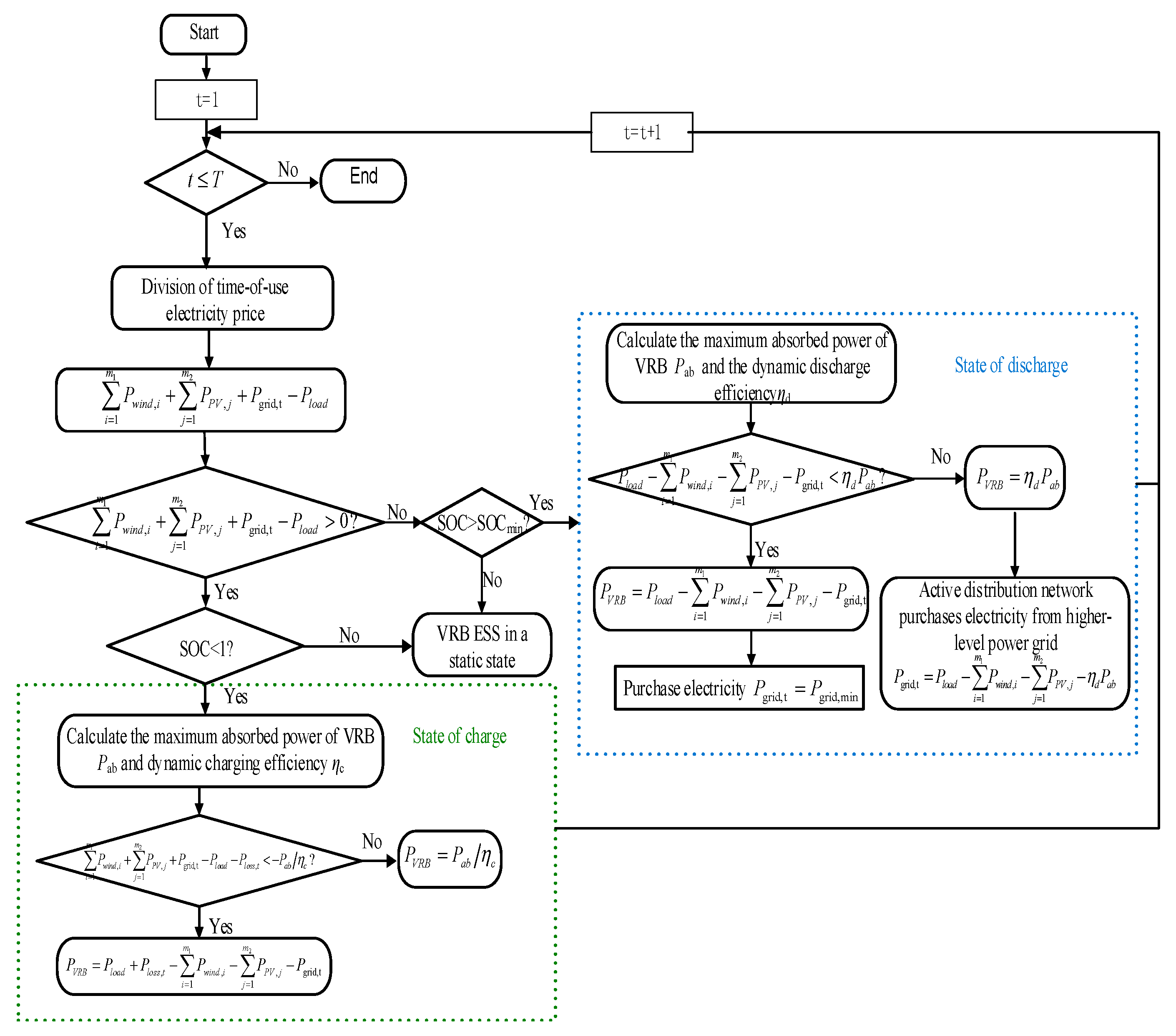
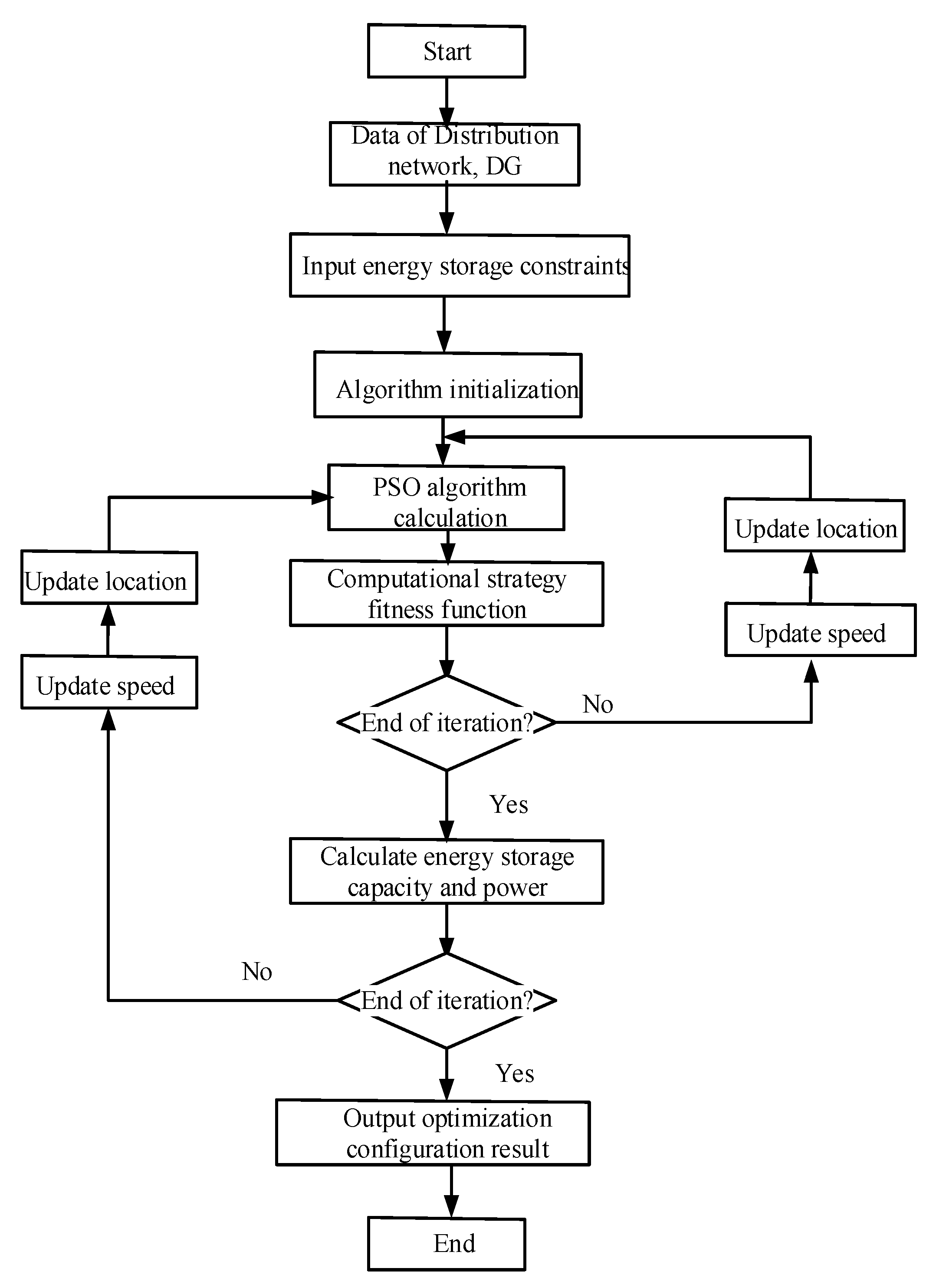
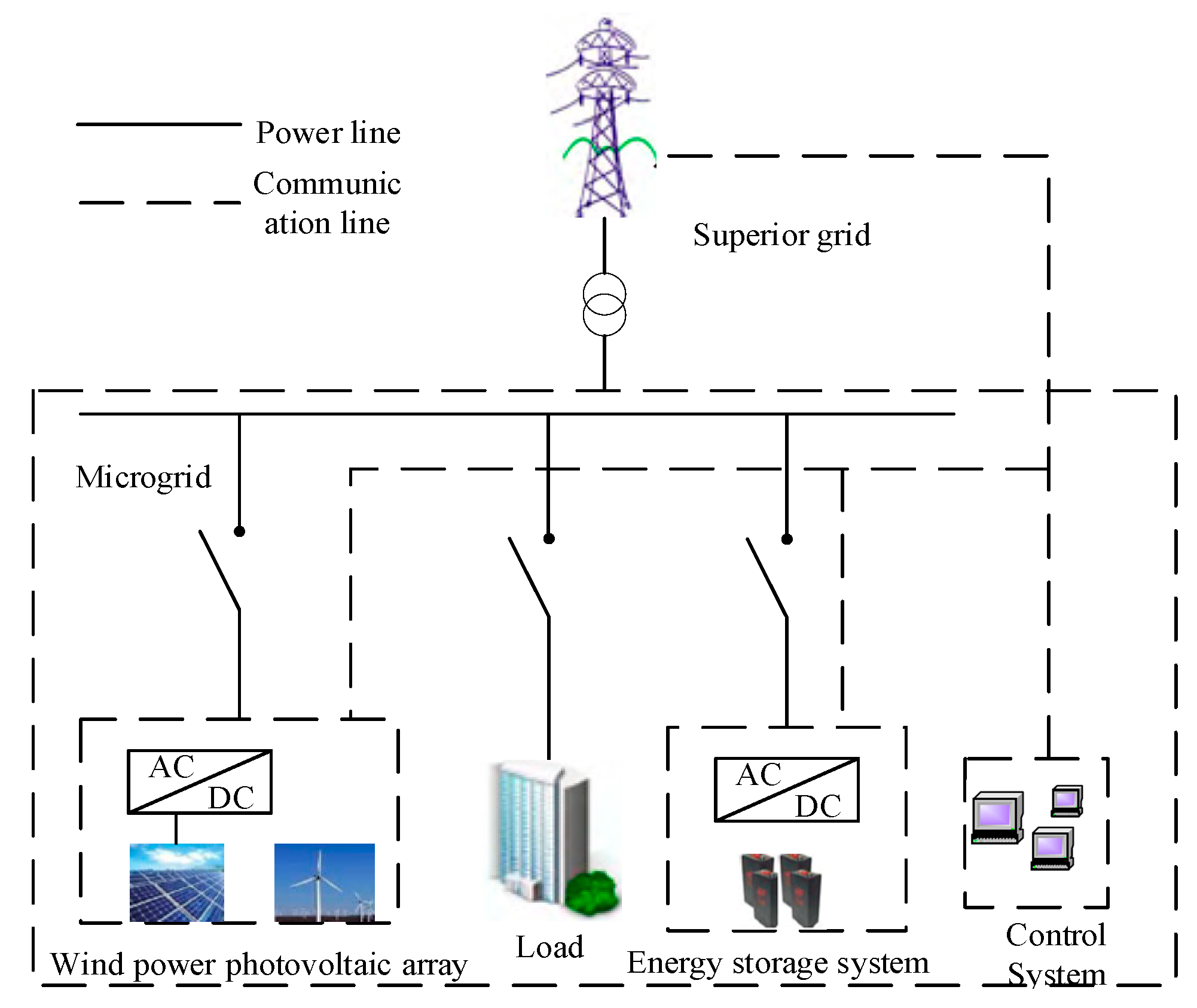
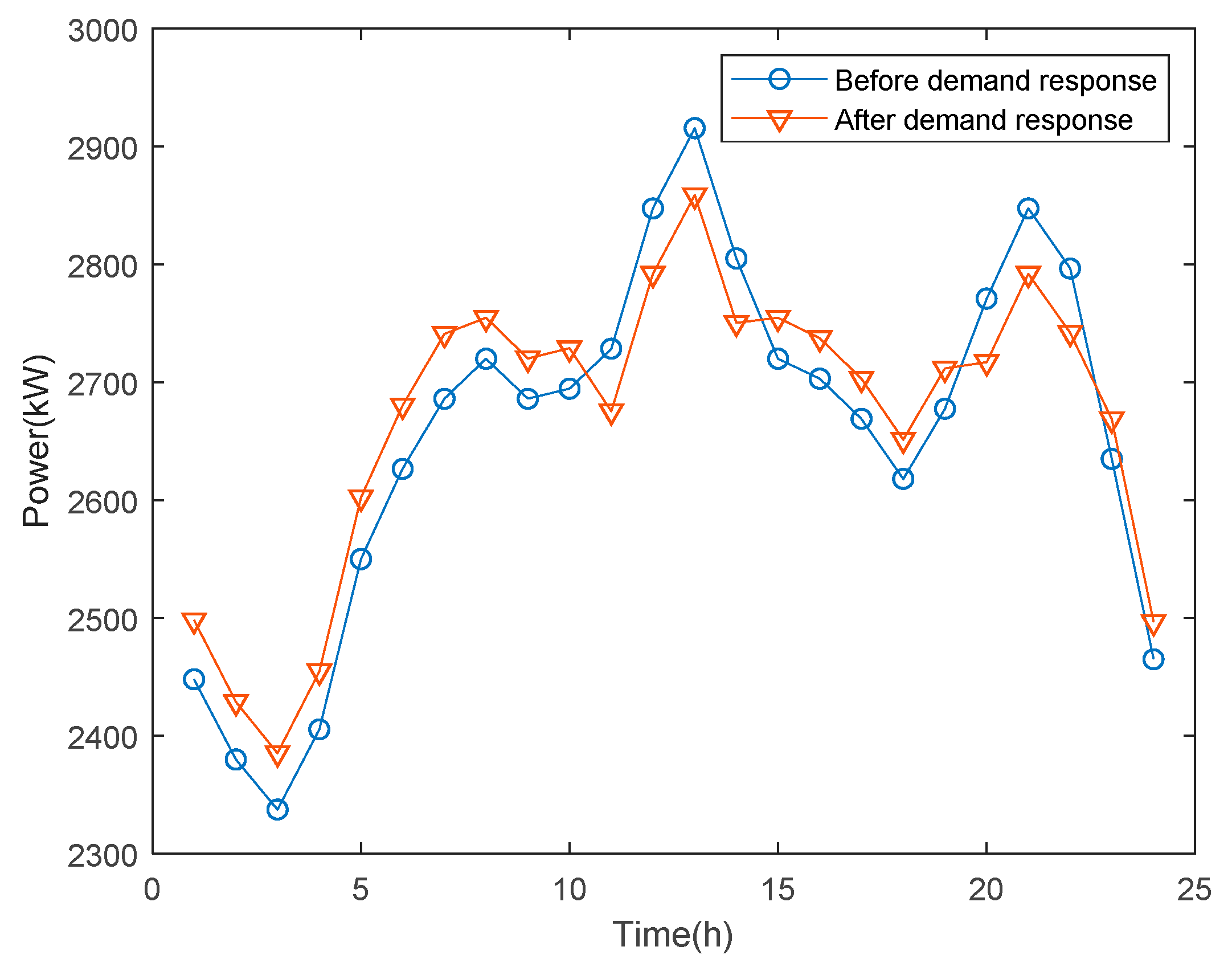
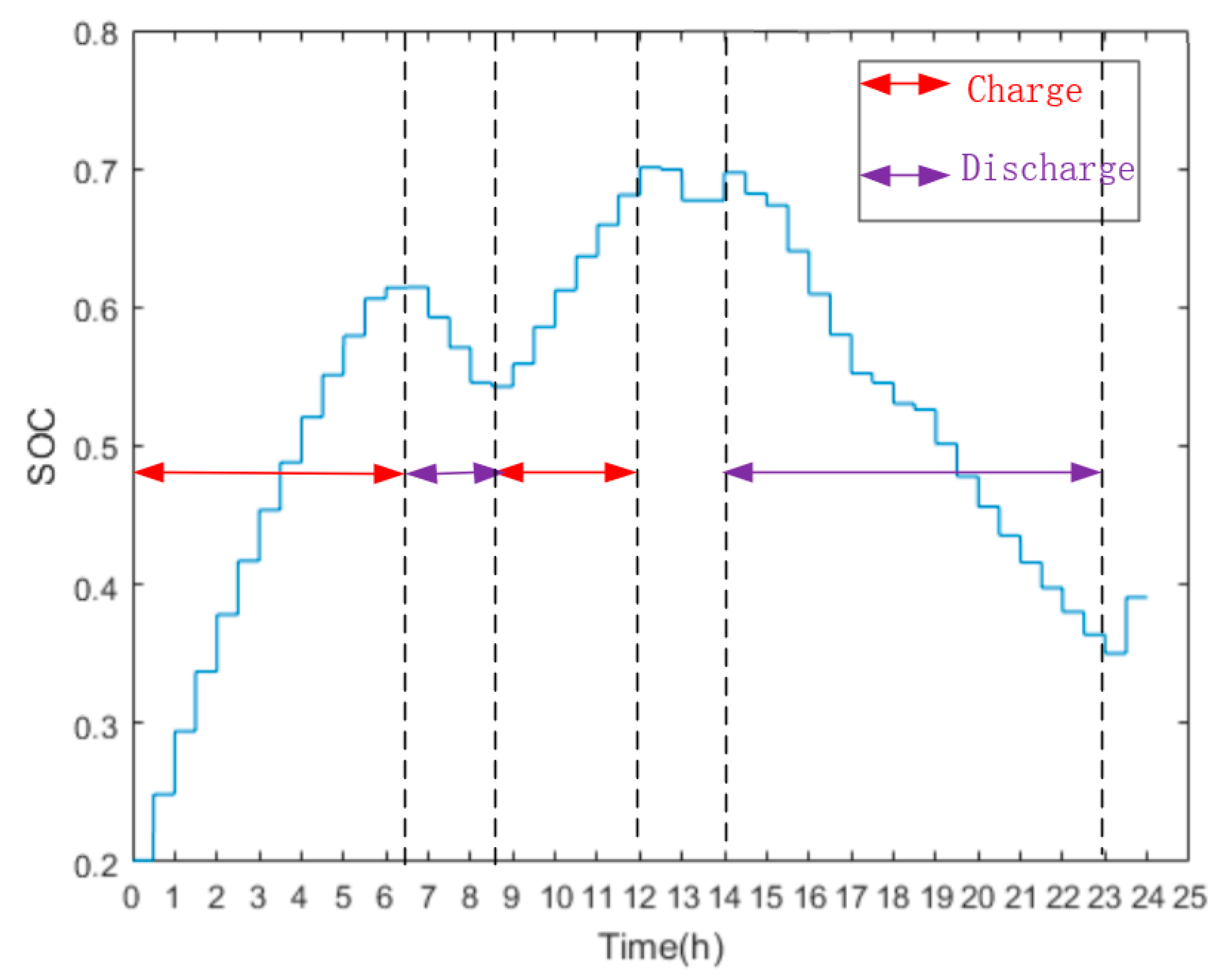
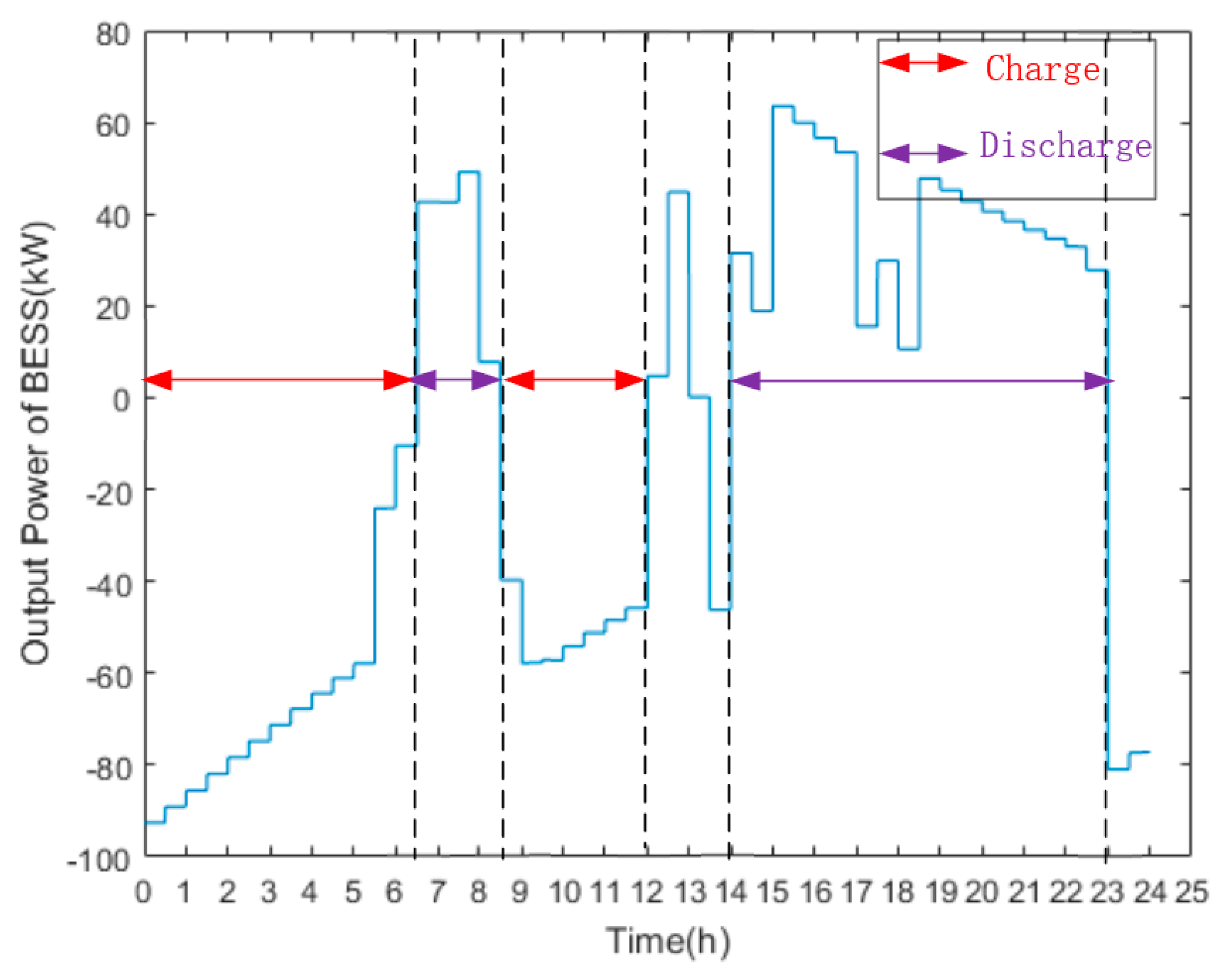
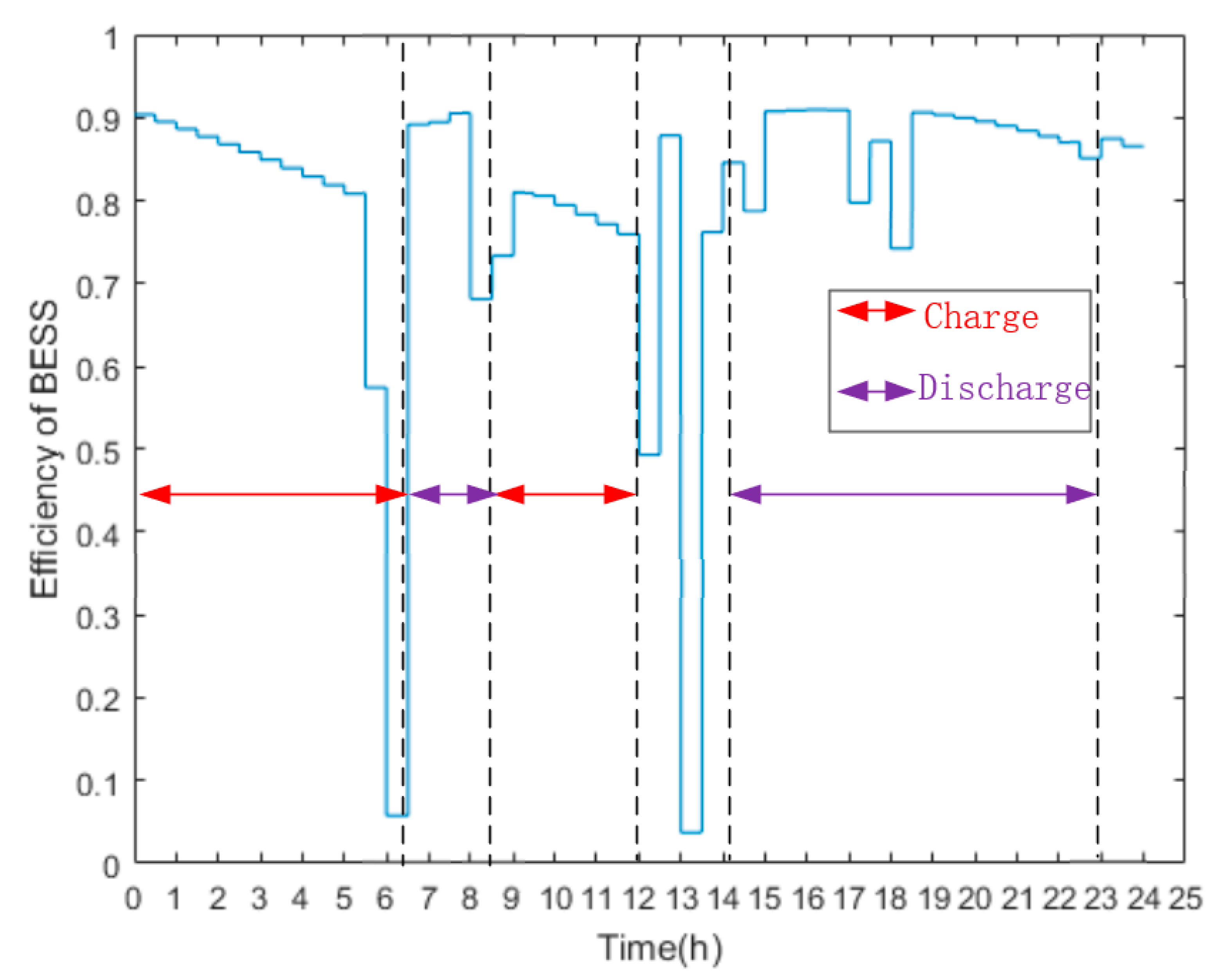
| PN/kW | EN/(kW·h) | F/$ | |
|---|---|---|---|
| Before demand response | 198 | 1473 | 30.18 |
| After demand response | 165 | 1321 | 23.98 |
| Ctol/$ | Bdirl/$ | Cpvl/$ | |
|---|---|---|---|
| Before demand response | 273.66 | 345.31 | 101.83 |
| After demand response | 260.12 | 307.43 | 71.29 |
| DG | EN/(kW·h) | PN/kW | F/$ |
|---|---|---|---|
| 0.1 | 1056 | 122 | 27.337 |
| 0.2 | 1208 | 139 | 25.766 |
| 0.276 | 1321 | 165 | 23.980 |
| 0.3 | 1464 | 199 | 21.670 |
| 0.4 | 1450 | 213 | 23.826 |
| 0.5 | 1647 | 250 | 22.585 |
© 2019 by the authors. Licensee MDPI, Basel, Switzerland. This article is an open access article distributed under the terms and conditions of the Creative Commons Attribution (CC BY) license (http://creativecommons.org/licenses/by/4.0/).
Share and Cite
Gong, Q.; Fang, J.; Qiao, H.; Liu, D.; Tan, S.; Zhang, H.; He, H. Optimal Allocation of Energy Storage System Considering Price-Based Demand Response and Dynamic Characteristics of VRB in Wind-PV-ES Hybrid Microgrid. Processes 2019, 7, 483. https://doi.org/10.3390/pr7080483
Gong Q, Fang J, Qiao H, Liu D, Tan S, Zhang H, He H. Optimal Allocation of Energy Storage System Considering Price-Based Demand Response and Dynamic Characteristics of VRB in Wind-PV-ES Hybrid Microgrid. Processes. 2019; 7(8):483. https://doi.org/10.3390/pr7080483
Chicago/Turabian StyleGong, Qingwu, Jintao Fang, Hui Qiao, Dong Liu, Si Tan, Haojie Zhang, and Haitao He. 2019. "Optimal Allocation of Energy Storage System Considering Price-Based Demand Response and Dynamic Characteristics of VRB in Wind-PV-ES Hybrid Microgrid" Processes 7, no. 8: 483. https://doi.org/10.3390/pr7080483
APA StyleGong, Q., Fang, J., Qiao, H., Liu, D., Tan, S., Zhang, H., & He, H. (2019). Optimal Allocation of Energy Storage System Considering Price-Based Demand Response and Dynamic Characteristics of VRB in Wind-PV-ES Hybrid Microgrid. Processes, 7(8), 483. https://doi.org/10.3390/pr7080483




